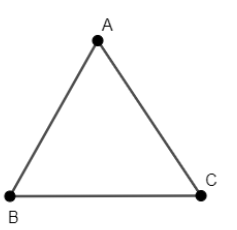Question
Question: In an acute-angled triangle ABC, if \(\sin \left( A+B-C \right)=\dfrac{1}{2}\) and \(\cos \left( B+C...
In an acute-angled triangle ABC, if sin(A+B−C)=21 and cos(B+C−A)=21, then find the measure of each angle of the triangle.
Solution
Hint: Find the acute angle solution of the equations sinx=21 and cosx=21. Write equations based on the data given in the question. Solve those equations to calculate the measure of all the angles.
Complete step-by-step answer:
We know that in an acute-angled triangle ABC, we have sin(A+B−C)=21 and cos(B+C−A)=21. We have to calculate the measure of each angle of the triangle.

We will first calculate the acute angle solution of the equations sinx=21 and cosx=21.
We know that sin30∘=21 and cos45∘=21. We also know that sin(A+B−C)=21 and cos(B+C−A)=21.
Thus, we have A+B−C=30∘.....(1) and B+C−A=45∘.....(2).
We also know that the sum of all angles of a triangle is 180∘. Thus, we have A+B+C=180∘.....(3).
We will now simplify all the equations.
Subtracting equation (1) from equation (3), we have (A+B+C)−(A+B−C)=180∘−30∘.
Thus, we have 2C=150∘. Rearranging the terms of the previous equation, we have C=2150∘=75∘.....(4).
Substituting equation (4) in equation (2), we have B+75∘−A=45∘. Rearranging the terms of the above equation, we have B−A=45∘−75∘=−30∘.....(5).
Similarly, substituting equation (4) in equation (3), we have 75∘+B+A=180∘. Rearranging the terms of the above equation, we have A+B=180∘−75∘=105∘.....(6).
We will now simplify equations (5) and (5). Adding equation (5) and (6), we have B−A+(A+B)=105∘−30∘. Thus, we have 2B=75∘⇒B=275∘=37.5∘.
Substituting B=37.5∘ in equation (6), we have A+37.5∘=105∘. Thus, we have A=105∘−37.5∘=67.5∘.
Hence, the measure of all the angles of the triangle is ∠A=67.5∘,∠B=37.5∘,∠C=75∘.
Note: We can’t solve this question without using the fact that the sum of all interior angles of a triangle is 180∘. If we don’t use this fact, we will get an incorrect measure of the angles of the triangle. We must write the measures of all the angles in degrees or radians.
